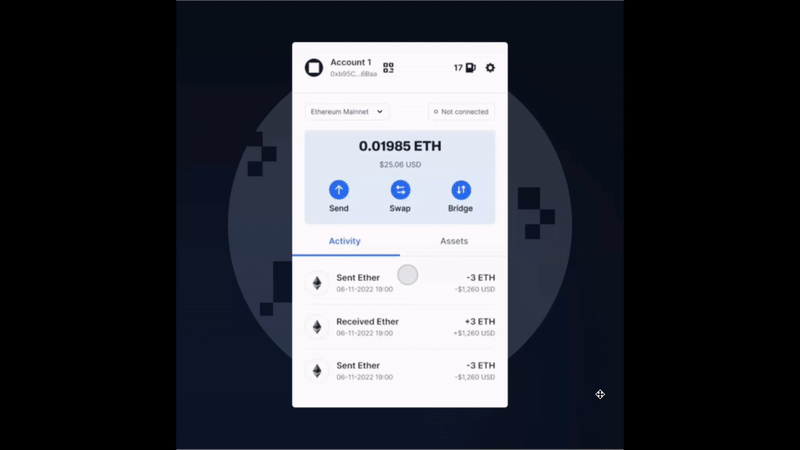LI.FI has announced a $29M Series A extension, led by Multicoin and CoinFund. Read Here.

LI.FI for Wallets
A single API for all of your cross-chain needs.
LI.FI powers cross-chain transactions for MetaMask, Omni, Edge, Frontier, Obvious, BlockWallet, Liquality, jWallet, Pepper Wallet, and more.
We want to do the same for your wallet.
Problem: Cross-Chain Support Is Difficult
Gone are the days when users only want to hold funds on Ethereum. With the advent of L1s, L2s, and innovative dApps, crypto is now a multi-chain ecosystem. Easily moving assets and messages from chain to chain is paramount.
Nowadays, many wallets support the custody of assets on most EVM chains. However, letting users take action with multi-chain assets is quite limited.
That’s because cross-chain transactions require integrations with bridges, DEXs, DEX aggregators, message-passing protocols, and unique blockchains.
For example, for a wallet wanting to let a user execute a simple transaction like converting MATIC on Polygon to AVAX Avalanche, the wallet would need to directly support DEXs on both chains, along with a bridge to connect the two DEXs. While this can work for a single implementation of a cross-chain token pair, each cross-chain token pair has a different set of DEXs and bridges necessary to efficiently convert tokens – meaning that to create an extensible cross-chain experience, wallets need to directly support and maintain integrations with tens of DEXs and bridges. That is a huge burden.
LI.FI, a single API solution for any cross-chain transaction, is here to help wallets thrive in this multi-chain reality with minimal developer overhead.
Solution: LI.FI’s Bridge and DEX Aggregation Skillz
LI.FI is a universal liquidity solution for teams building in the crypto space, with over 50 businesses using our API, SDK, or widget.
In the context of wallets, LI.FI’s API allows teams to support cross-chain transactions with minimal developer burden. Wallets only need to think about integrating a cross-chain solution ONCE. By implementing LI.FI, wallets can easily pull liquidity from 15+ chains, 25+ DEXs, and 15+ bridges from now until forever (full list).
LI.FI’s API is the ultimate routing solution in the DeFi space. So far, there are five major use-cases that LI.FI unlocks:
Bridging: we support all of the major bridges in the space, including Across, Hop, Connext, Multichain, Stargate and 10 others. At minimum, LI.FI can be used by wallets to find the most efficient bridging opportunities between chains.
Same Chain Swaps: LI.FI is also a DEX aggregator. For any same-chain swap, we can route users through 1inch, Paraswap, 0x, Uniswap, or one of our other DEXs.
xChain Swaps: our smart contracts efficiently and effectively route users from token X on chain A to token Y on chain B, taking into account the price, speed, number of clicks, and security of each transaction.
xChain Zaps: LI.FI can help wallets build abstracted cross-chain experiences. For example, wallets can build “Zaps” on top of LI.FI, wherein token X on chain A is deposited in contract W on chain B in a single click starting on chain A. “Zaps” can be extended to omni-chain NFT purchasing, DeFi services, cross-chain staking, and more.
Monetization: all volume going through LI.FI can be monetized by the wallet! Reach out to our team on Discord or email sales@li.finance for more information!
Here’s an example of LI.FI being used by BlockWallet as a bridging solution:

Conclusion
LI.FI is available to all developers and can be embedded into your wallet in less than a week. To begin your integration, start with the docs.
To summarize, LI.FI is a plug-and-play solution for wallets looking to support cross-chain transactions. We envision LI.FI being helpful in the following scenarios:
Onboarding users to new chains
Monetizing swaps, bridging, and zaps
Making your wallet stickier (users will never have to leave to find a token elsewhere!)
FAQ: LI.FI for Wallets
Get Started With LI.FI Today
Enjoyed reading our research? To learn more about us:
- Head to our link portal at link3.to
- Read our SDK ‘quick start’ at docs.li.fi
- Subscribe to our newsletter on Substack
- Follow our Telegram Newsletter
- Follow us on X & LinkedIn
Disclaimer: This article is only meant for informational purposes. The projects mentioned in the article are our partners, but we encourage you to do your due diligence before using or buying tokens of any protocol mentioned. This is not financial advice.